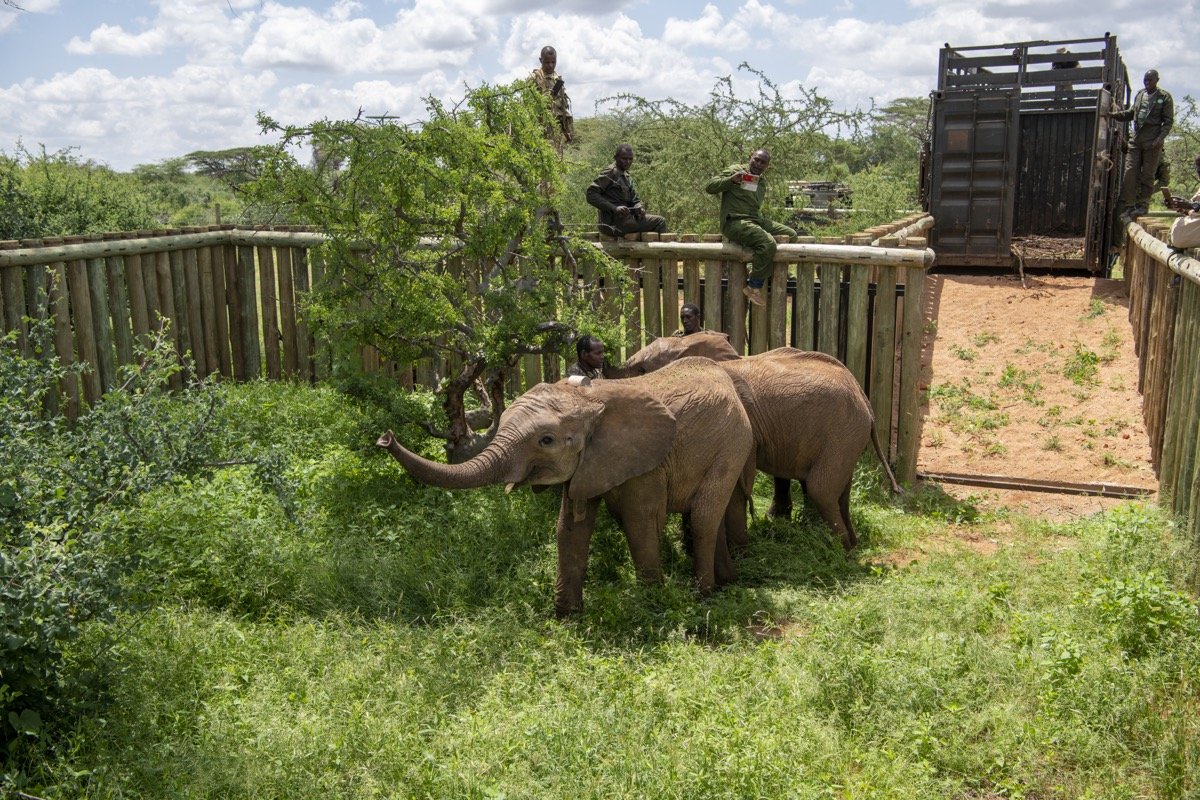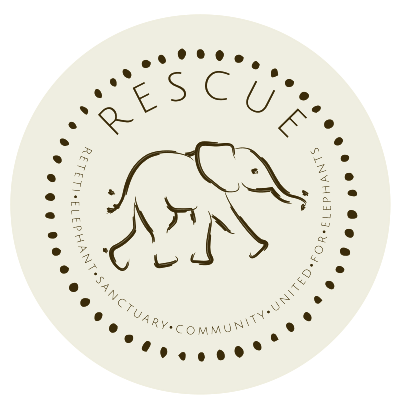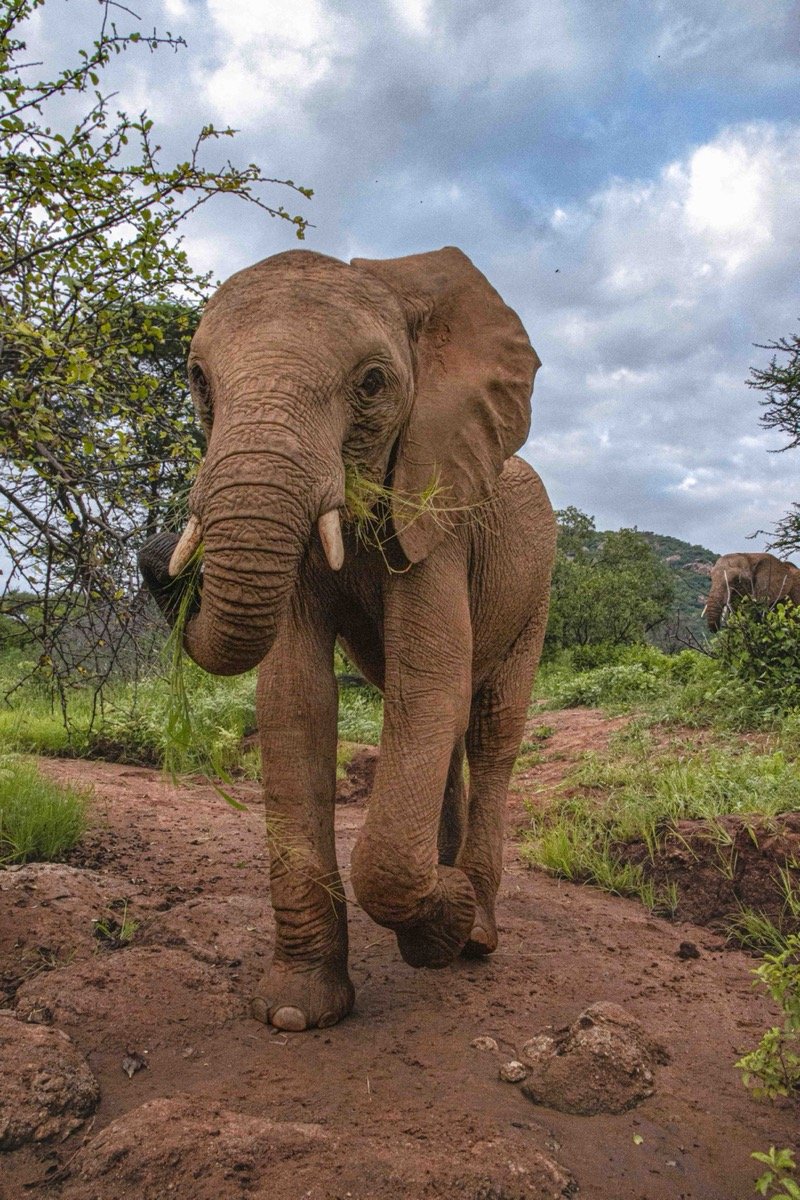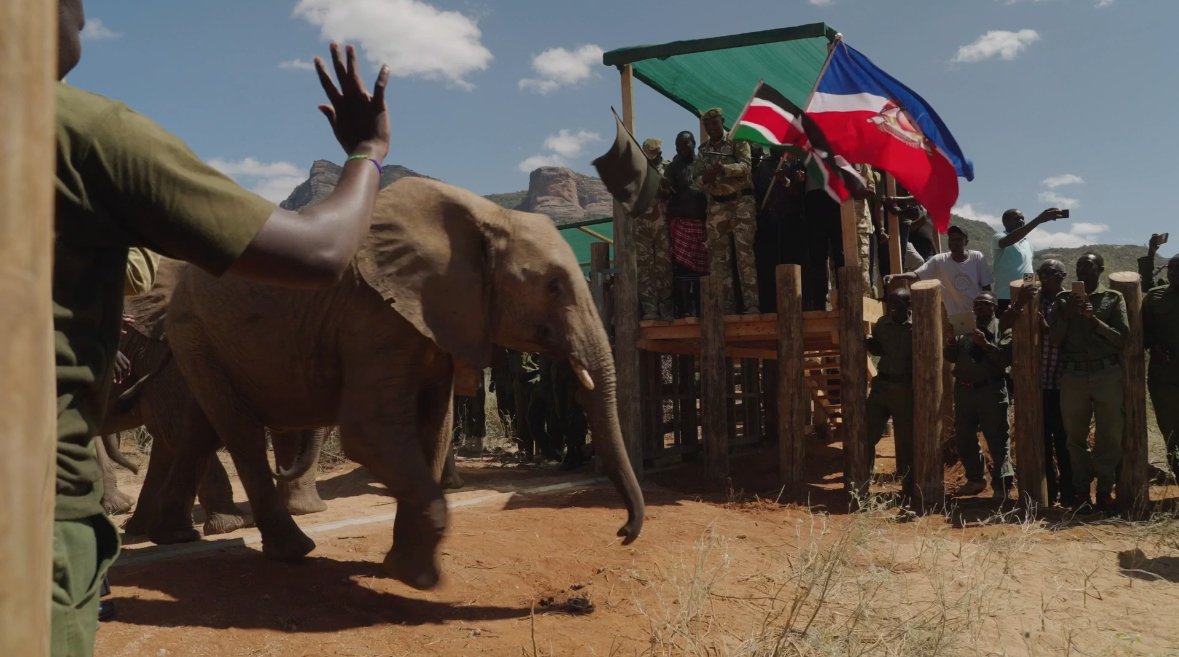We rescue, to release.
A dedicated page for all information and updates about our release herd. Follow along and support our rewilding efforts!
In a profound act of unity, an indigenous community comes together to rewild orphaned elephants onto their shared land.
To support a thriving world for all, we at Reteti Elephant Sanctuary and The Sarara Foundation believe it is essential to create strategies that foster peaceful coexistence between people and wildlife. The rewilding of the 13 elephant orphans onto Namunyak Conservancy represents this in its truest form.
Orphaned as babies, these elephants returned to the wild amid bittersweet tears
Kapai and her herd were “rewilded” this month after years in an innovative Kenyan sanctuary, where keepers restored their health and prepared them to live free.
By Ami Vitale and Rael Ombuor
The 13 elephants in 2024’s release herd have started their next chapter in Namunyak Community Conservancy, where Reteti Elephant Sanctuary is located.
SUPPORT THE RELEASE HERD
Adopt one of our release elephants and follow this exciting journey from within as a Foster Parent!
The rewilding of 13 elephant orphans from Reteti Elephant Sanctuary onto community-owned land is a testament to the coexistence between indigenous people and wildlife, and represents the future of conservation.
Follow the latest news
Click below to read our latest blog posts or follow the journey on social media:
Frequently asked questions about the release of Reteti’s elephant orphans
-
After being successfully rehabilitated at Reteti Elephant Sanctuary, 13 elephant orphans are ready to return permanently to their natural habitat in Namunyak’s 850,000-acre wilderness. They are: Lemorijo, Kapai, Sere, Olpejeta, Metumi, Lorian, Meibae, Sarara, Hamsini, Kikwar, Kelele, Kone and Sesia. Read more about the ‘graduates’ here.
-
The herd will be released in an area surrounding Reteti Elephant Sanctuary – right here in Namunyak Community Conservancy.
-
A joint elephant release committee comprising stakeholders including Kenya Wildlife Service (KWS), Wildlife Research & Training Institute (WRTI), Save The Elephants (STE) and more was established to work in close collaboration and consultation to guide and spearhead the release program.
The assessment team used a framework in line with the already existing KWS Release Protocol to guide in assessing possible release sites. A shortlist of sites were created and then evaluated according to several key parameters such as:• Access to natural browse, water and more
• Risk of predation
• Potential for human-elephant conflict (proximity to agricultural zones)
• Space for expansion
• Community tolerance
• Existing free-ranging elephant population
• Proximity to veterinary servicesIn May 2023 the committee visited all shortlisted sites to assess their viability and the current site near Reteti, in Namunyak Conservancy was recommended as the most favourable release site. Read more about this process in this blog.
-
It’s the first time that elephants are released on community-owned land. Namunyak Conservancy, including Reteti Elephant Sanctuary, is owned and run by the indigenous Samburu who have co-existed with wildlife for generations. Since Namunyak is community-land, it is not fenced like a national park.
Thanks to the incredible community conservation efforts of the Samburu people, there has not been any poaching incidents in Namunyak in decades. Moreover, wildlife has returned to this landscape in great numbers and today, Namunyak has the second-largest population of elephants in Kenya (more than 6,000), one of the biggest populations of Reticulated Giraffes in Kenya, and it is also home to the critically endangered Grevey’s Zebra as well as aa range of other endangered animals.
Namunyak means ‘Place of Peace’ in Samburu – and it is truly living up to its name! -
The Samburu Community is incredibly proud of the success of Namunyak and Reteti – as they both stand as testimonies to their remarkable conservation efforts. This release serves as yet another affirmation of their dedication and hard work.
Having lived alongside elephants for generations and believing they are the ancestors of elephants, the Samburu Community feels a deep sense of custodianship over the orphans. They take great pride in seeing the orphans return to the landscape that both the Samburu and the elephants call home.
-
One of our Release Project's most important building blocks was an awareness drive to ensure that the entire Samburu community of Namunyak was fully informed.
Over the course of three months, Peter Lenasalia – Reteti’s Manager, and Titus Letaapo – The Sarara Foundation’s Director of Community, visited each of Namunyak’s 12 manyattas (homesteads) to communicate the plans and all the steps for the release, and receive everyone’s approval to proceed. Meetings were held across Namunyak in each manyatta until every Mzee (elder) and Moran (warrior) was informed.The awareness drive was a considerable commitment because of Namunyak’s sheer size, remote setting, and rough and mountainous terrain. The community’s confidence and support will help drive the success of the reintegration of these elephants into Namunyak’s landscapes, where they will encounter and engage with both people and other animals in the wild.
Learn more about the community’s passionate support for the release in this blog. -
All the Reteti keepers are from the Samburu community, as well as all of Namunyak’s rangers. Furthermore, 12 community volunteers have also been employed from surrounding villages in Namunyak to help monitor the successful integration of the released elephants. These Samburu morans (warriors) have been recruited and trained to deal with various situations that may arise, and while continuing with their daily lives and living at home, they also look out for the elephants within the release site.
-
This will be the fourth release since Reteti opened in 2016. The first 10 orphans from the sanctuary were released into Sera Wildlife Conservancy – which is located 20 miles east of Reteti – in three cohorts. The first cohort was released in 2019.
-
We’ve learnt so many valuable things during our first releases, as well as through studies of wild orphans by Save the Elephants (STE) and academic institutions. For example, one of the best strategies for an elephant orphan to survive in the wild is to be accepted by an elephant herd with youngsters of their own. Released orphans that hadn’t been ‘adopted’ in this way were more restricted in their movements, and unable to access different water points and feeding areas. This is why we keep emphasising the importance of meaningful engagements with free-ranging elephants as one of the most important factors for successful rewilding.
-
Ranging around the ages of 6 and 7, the orphans in this release herd are all at a stage where they are highly susceptible to learning important social and survival skills from wild elephants in the bush – which is why it’s so important for them to engage with free-roaming elephants and becoming integrated with wild herds!
They are still young enough to develop vital survival instincts and are at the optimal age to begin the rewilding process and adapt to the wild environment. These elephants are well-developed in terms of tusks and are no longer reliant on milk, and large enough to be safe from predation.
-
Once the 13 elephants leave Reteti's boma early in the morning on the day of their release, they'll make their way through the gates of the sanctuary for the last time – with the sanctuary’s keepers walking proudly at their sides!
Just like most days in the past few weeks and months, they'll spend the day foraging and browsing in the release site, but when the day starts drawing to a close, it will be the first time that they won’t return to Reteti. To make the transition as seamless as possible, we've built a special ‘release boma’ right there in the bush for them, where they’ll also receive their last milk bottles from the keepers.
As a wonderful combination of lasts and firsts, the process will see them wake up in the release boma on their first morning in the wilderness – and then a whole day of additional exploring and discovery awaits! The first two days will be filled with opportunities to familiarise themselves with the valley and waterholes, as they gradually become accustomed to being in this area.
On the third morning, we will open the gates of the release boma for the last time, and as the final step in the release, the herd will then remain in their natural habitat. Whether or not they choose to do this will however remain up to them and their own timing, and if they decide to return to the boma for one or more nights, we will be welcoming them with open arms! After all, we have always known that this will be a ‘self-release’ process - in which the rewilding herd will lead the way.
-
Of all the considerations that had to be taken into account in the choice of a release site, the availability of natural resources was one of the most important ones. Namunyak Conservancy offers a great habitat, vegetation and natural browse, as well as fresh clean spring water and existing mineral licks. We’ve also created a waterhole near the release site to support the release herd, and to attract more wild elephants.
-
The elephants have spent their days out in the bush since they arrived at Reteti where they'd encounter other animals regularly – so they never became unfamiliar with the bush and its inhabitants.
One of the reasons this area within Namunyak was chosen as the release site is because of the low risk of predation. Added to that, there are also a great number of wild elephant herds in the area, and the release herd already spent a lot of time engaging with these elephants on their daily wilderness walks. Meaningful interactions with free-roaming elephants is in fact one of the most important factors for successful rewilding!
-
Reteti’s orphans are never isolated from the environment of their birth and spend their days being taken on walks in the wild from the start. Every day, they learn more about what to eat, where to find water, and how to respond to predators and other dangers. What’s more, as they engage more and more with free-roaming elephants in the wild, they will also learn more from them about staying safe from dangers and predators in the bush.
-
Surrounded by Namunyak Community Conservancy, the release herd will also encounter the pastoralist Samburu Community and their livestock herds with whom they share this landscape. The Samburu has lived harmoniously alongside Northern Kenya’s wildlife for generations and their passion for conservation is at the heart of grassroots, community-driven initiatives like Reteti Elephant Sanctuary. Read more about the community’s wholehearted support for the upcoming release on this blog.
-
As the orphans are being prepared for release, the research team is observing and recording how they interact with each other, their keepers, and with food and water sources. This data helps to build an understanding of each individual elephant and provides a baseline from which to evaluate their later progress.
Once released, their progress will be studied using GPS tracking collars, camera traps and drones. Field researchers from Reteti – trained by and in support of Save the Elephants and San Diego Zoo Wildlife Alliance – will monitor the orphans daily.
The tracking data will also highlight their progress as they adapt and reintegrate in the wild – and enable us to keep improving our operations on the ground and evaluate the success of our rehabilitation program as we strive to ensure the best possible outcome for each orphan in our care.
-
This herd will be released within their home range. In their assessments of various options for release sites, the joint committee specifically cited that one of the strengths of Namunyak as a release site was that the site offered a high probability for the calves to meet or reunite with their original kin. (Read more about the site assessment here.)
-
We can't tell for sure! What we do know is that for the past 8 months, the release herd had been compared to teenagers who are about to graduate high school, didn’t want to be at home any more, and preferred to live on their own!
There is of course a chance that they may come by to say hello, but then again – they've been ready to be truly wild for quite a while! So in the end, they will probably prefer the bush to the boma. If we notice that something isn’t quite right, we do have a new 'release boma' ready for them right there in the bush – and they’d be able to find refuge.
During the release process, we will be walking them across to this release boma, and they will be able to choose their own timings there – for example, whether they want to spend the night out in the wild or come back to sleep at this boma. Essentially, this will be a 'self-release' in which they lead the way!
-
Of course! Once they are released, they remain part of Reteti’s world – and each of Reteit’s orphans remains in our care for life! The type of monitoring and care they receive may change – and in fact become even more advanced (including GPS and aerial tracking) when they’re permanently in the bush, but we’ll still be very much hands-on, with keepers who live permanently nearby, vet services on standby, research being conducted, water sources and vital infrastructure being maintained, and more!
We are immensely grateful for every Foster Parent who joins the Reteti Family – and fostering a member of the release herd is such a special opportunity to make a meaningful difference in Namunyak’s wild elephant population!
Simply visit our Adoption Page to become a Foster Parent to Kapai, Lorian, Meibae, Sarara or Kikwar – and become part of their very special journey today!
The Challenge of Release
The orphans have a lot to learn to be able to survive in the wild. They need to know how to find food and water, navigate the politics of elephant life, and avoid trouble with predators or people. Normally, they’d learn these skills from their mothers and relatives.
At Reteti, their human caretakers start this process before they eventually join their next ‘teachers’ in the bush. Spending time with free-roaming adult elephants is the best way for the orphans to start learning the ways of the wild, and to join elephant society.
As the calves grow and need more space, they move into a bigger enclosure and no longer sleep in stables. Each at his or her own pace, they start spending more time foraging for themselves and needing less milk. They start relying less on keepers and more on their fellow elephants. Bonds between them start to strengthen, creating alliances that can last a lifetime
Crucially, Reteti’s orphans are never isolated from the environment of their birth and spend their days being taken on walks in the wild from the start. Every day, they learn more about what to eat, where to find water, and how to respond to predators like lions and other dangers.
Surrounded by Namunyak Community Conservancy, they also encounter the pastoralists and livestock herds with whom they share the landscape. When they bump into wild elephants, they start important interactions with the wider elephant society.
Understanding Rewilding
As orphans are prepared for release, the research team observes and records how they interact with each other, their keepers, and with food and water sources. This data helps to build an understanding of each individual elephant and provides a baseline from which to evaluate their later progress.
Once the orphans are released, their progress is studied in a way that avoids contact with people as far as possible. Using technology such as GPS tracking collars, camera traps and drones, field researchers from Reteti – along with researchers from Save the Elephants and San Diego Zoo Wildlife Alliance – monitor the orphans on a daily basis.
Frequently asked questions about collaring
-
This project is first of its kind as the orphans are being released into a Namunyak Conservancy, populated by the indigenous Samburu and 6,000 wild elephants. Namunyak is not a fenced national park. This an exciting step for conservation throughout Africa because it opens up vast new tracts of landscape for potential rewilding.
The elephants were orphaned and rescued here in this landscape, and now they're returning to the land. Elsewhere in Africa, wildlife is often released in a different landscape from where they were originally orphaned/born.
The collars will allow ongoing monitoring, research and data collection. Over the longer term, tracking data helps build knowledge of elephant behaviour. In an increasingly crowded Africa, this information is key to preserving habitat and the corridors that link areas used by both elephants and other wildlife. The data collected will help inform decisions that could protect hundreds more elephants in the years to come.
Tracking the elephants was also a government wildlife department condition for their release. Save the Elephants and Kenya Wildlife Service have been using tracking collars to give a voice for elephants and to help protect them for several decades, and the conservation benefits of the data has had enormous benefits for elephant conservation efforts across Africa.
-
The elephant collars are especially helpful in monitoring:
Wellbeing
From being able to respond to injuries to notice any concerning behaviour in real-time, it will help us to track their safety and welfare around the clock.Social integration
Providing us with real-time information on the engagements between the released elephants and wild elephant herds, the tracking data will enable us to see if they are integrating sufficiently and successfully to create the necessary bonds needed to reintegrate fully into the wild.Feeding behaviours
It will be crucial for the elephants to maintain their body weight once they’re released, so we will be watching their feeding behaviours with very keen eyes! By tracking their preferences in terms of browsing areas and patterns, we will be able to see if they are making the most of the natural resources available to them in the wild.Activity patterns
By continuously monitoring the activities of the rewilded elephant orphans, we can form a clear picture of their release milestones. This will help us to identify and address any issues early on – and inform our planning for future release projects.Human interactions
Namunyak Community Conservancy has been home to both wildlife and the Samburu people for generations, and their harmonious relationship forms the foundation of the grassroots conservation movement at the heart of Reteti Elephant Sanctuary. As the release area is set within community-owned land, the elephants will encounter both people and their livestock during the course of their normal activities, and we will monitor these encounters as part of our ongoing observations and research. -
GPS collars are the best option for Samburu elephants as they've been tried and tested over the years – thanks to the incredible work of Save the Elephants. A tremendous amount of research goes into the design of these collars and elephants get used to them very quickly. Think about how it feels when you put a necklace on in the morning – you even forget it’s there and sometimes you find yourself touching your neck to see if you still have it on. While the collars might look strange to the human eye, we can assure you it doesn’t bother them – they're not heavy.
-
Not at all! While it might look strange to the human eye, the weight of a collar on an elephant is the equivalent of a small pendant necklace around your neck. They're not heavy and fit comfortably loose. The collars work like a belt with different holes and they'll be adjusted as the elephants grow to remain loose and comfy.
Looking back at our previous releases
The first 10 orphans from Reteti were released into Sera Wildlife Conservancy – 20 miles east of Reteti – in three cohorts.
Cohort 1
May 2019
Warges, Lingwezi and Sosian were reintroduced to the wild.
Cohort 2
November 2019
Shaba, Mpala and Pokot joined a herd of over 30 free-roaming elephants.
Cohort 3
June 2020
Loisaba, Baawa, Lchurai and Nadasoit were released into their new wild home.

One of the first cohort of orphans to be rewilded – Nadasoit, Baawa, Lchurai and Loisaba – being released in May 2020. Photo: Ami Vitale

Tracking the orphans following their release helps to ensure they remain healthy and safe. The data also helps understand what works best when it comes to rewilding. Photo: Jane Wynyard/Save the Elephants

Nadasoit getting her GPS tracking collar fitted at Reteti prior to her release. Photo: Jane Wynyard/Save the Elephants

Three of the orphans released in 2019 photographed during an aerial patrol by Save the Elephants. Photo: Jane Wynyard/Save the Elephants


























